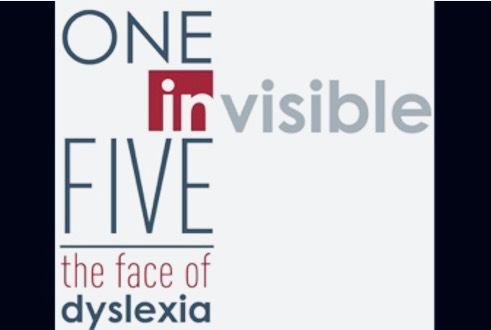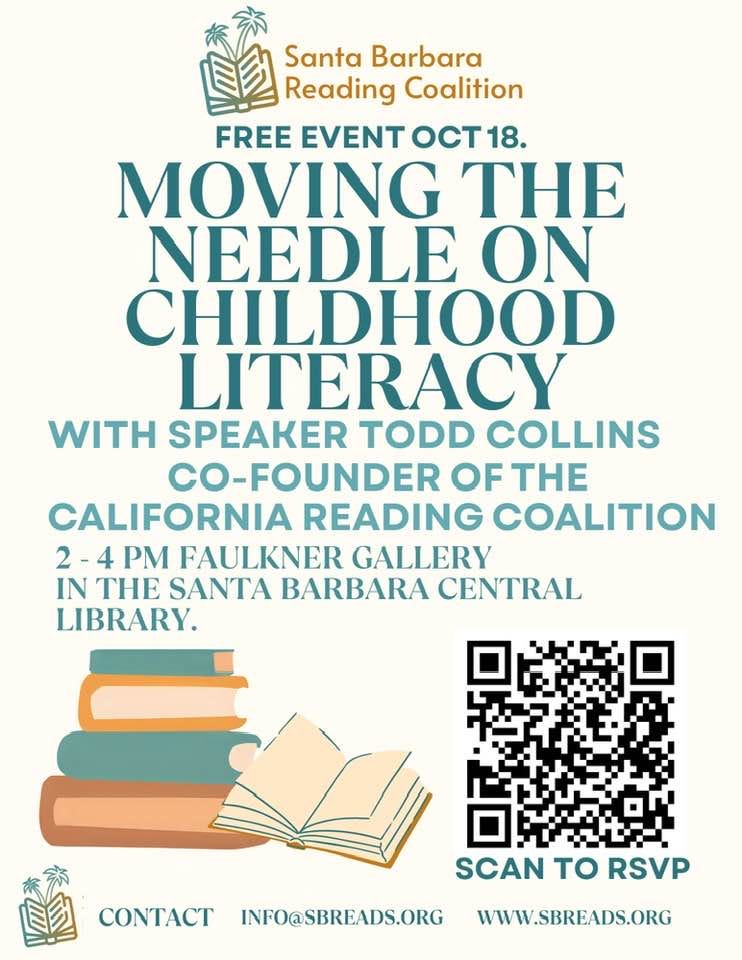To Honor Dyslexia Awareness Month, SB Central Library Will Host Special Literacy Events in October
A special photo exhibit in the East Gallery makes visible what so often is invisible, and the SB Reading Coalition hosts a statewide literacy leader in advance of the annual California Reading Summit.
By Cheri Rae
Libraries naturally are places where proficient readers feel welcome and comfortable perusing the stacks and pursuing the stories contained in books.
But what of those who struggle to read? Where do they belong in the library?
The Central Library regularly offers adult literacy instruction and Orton-Gillingham tutoring for children. And in October, which is Dyslexia Awareness Month, it is felicitous that the library also will host special events that address reading struggles, which are sponsored by two local organizations—the Santa Barbara Reading Coalition and The Dyslexia Project.
Full disclosure: As a longtime literacy and dyslexia advocate, I am involved with both of them, and delighted to have the opportunity to bring these issues to the community. There is no more fitting place than the newly remodeled Central Library, where we once hosted monthly information sessions known as “Dyslexia Dialogues.”
It is a pleasure to return and welcome those for whom reading does not come easily; they, too have a place at our beloved, historic library.
A literacy leader speaks. The mission of the Santa Barbara Reading Coalition is to raise awareness about literacy in the community, and to encourage collaboration and communication aimed at developing and implementing lasting solutions to ensure that every child has the right to read. www.sbreads.org
To that end, the group is sponsoring speaker series featuring literacy leaders, the first one on Saturday, October 18, at 2 p.m., with Todd Collins of the California Reading Coalition. He will speak on “Moving the Needle on Childhood Literacy.”
When businessman-turned-literacy advocate Collins ran for Palo Alto Unified School Board in 2018, he had little knowledge of what he now terms “California’s reading crisis.” Once elected, however, he learned fast in a high-performing school district where reading scores were not where they should have been.
During his two terms on the school board, Collins and his counterparts recognized, as he termed it, “We weren’t serving all students equally well.”
They decided to solve the mystery: “Why were we so ineffective at teaching kids reading?”
They did their homework about the low literacy issue, so common at the district, state, and national level, studying what worked and what didn’t work across the country. The board prioritized the goal of early literacy proficiency and oversaw the implementation of the district’s “Every Student Reads Initiative.”
The initiative developed a coordinated effort to create sustained change to improve literacy outcomes in the district. In addition to the implementation of Science of Reading instruction and the appointment of a literacy director, the board set specific, measurable, time-limited literacy goals for the district to meet.
Collins said that admitting the existence of a problem is the first step in solving it; then comes developing a new approach and a long, sustained effort in solving it.
Since the efforts in Palo Alto began to move the needle, Collins has turned his sights to improving reading outcomes throughout the state as one of the founders of the California Reading Coalition, dedicated to solving the statewide literacy crisis.
The coalition came together in 2021, as a way to create connection among the state’s educators, advocates, researchers, district leaders, policy-makers, and concerned community members to address reading issues, to share information and experiences from all over California—and most importantly to learn from each other.
“In our community, when it comes to the schools, we’re all on the same side of the table,” he said. “Everybody wants what’s best for our children.”
The coalition produces studies and organizes the annual virtual California Reading Summit. This year’s summit, scheduled for October 30, is titled, “Moving the Needle on Early Literacy,” and features notables including advocate Kareem Weaver and researcher Maryanne Wolf—both of whom have spoken about literacy in Santa Barbara. You can register for the virtual event here. https://www.careads.org/summit
The art of advocacy. What do an architect, a paleontologist, a chemistry professor, an Olympic champion, an elected official and a filmmaker have in common? All of them are dyslexic and have something to say about it.
They are among those featured in a new photographic exhibit, “IN/VISIBLE: 1 in 5, The Face of Dyslexia” to commemorate Dyslexia Awareness Month.
Dyslexia is a hereditary difference in the brain that affects one in five individuals.
It can be the source of great strengths, innovative thinking, and much success, but the positive aspects are typically overlooked due to early struggles experienced in school.
Widespread lack of understanding about dyslexia, failure to screen for or identify it, and inappropriate instruction means that far too many bright young dyslexics experience unnecessary classroom difficulties in the early grades.
Their struggles in reading, writing, and spelling are wrongly interpreted as lack of intelligence, which too often negatively affects their academic accomplishment and opportunities, self-esteem, and even their ability to reach their full potential in adulthood.
Although about 20 percent of the population is dyslexic, there’s a general lack of awareness about dyslexia in schools, the workplace and the community. Whether you know it or not, chances are you know plenty of successful dyslexics who do all they can to hide it, and who have figured out workarounds to help them keep their secret.
They almost never tell their stories. But they all have one.
For several years, Monie de Wit, dyslexic photographer and sister-in-advocacy, and I have collaborated on this ongoing photojournalism project. The work-in-progress was borne of our frustration as advocates, by the realization that no matter how much we speak or write about dyslexia, words alone don’t seem to be enough to persuade the powers-that-be in the education establishment to meet the needs of those with this most common learning difference—or to recognize and value their unique abilities in the face of difficulties.
So we decided to address dyslexia in a different way—by making visible those who deal with the invisible. We have relied on art to inform minds and touch hearts in a way that goes beyond words in hopes of increasing awareness and understanding of the dyslexic experience.
The exhibit features portraits of a wide range of successful adult dyslexics—and their observations about dyslexia. It also contains a number of additional images of dyslexic individuals ranging in age from 7 to 94 years old.
For many of them, it was a first opportunity to speak out about their dyslexia—rather than trying to hide it. Completing the exhibit is a display of individuals who have been recognized over the years by the Santa Barbara County Board of Supervisors for their contributions to the dyslexia community, and images of assemblage artwork that serve to inform and inspire about dyslexia.
Participating in this photographic project has been empowering for those photographed; educational, and informational for those who view it. We invite you to take a take a look for yourself.
And for the 1 in 5.
See the exhibition. “IN/VISIBLE: 1 in 5, The Face of Dyslexia” will be on exhibit in the East Gallery at the Central Library throughout the month of October, Dyslexia Awareness Month. It will be featured on the Downtown Organization’s First Thursday Artwalk on October 2.
Literacy advocate Cheri Rae is the author of “Dyslexialand: A Field Guide for Parents of Children with Dyslexia.”


